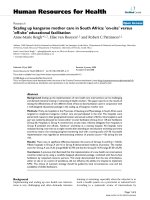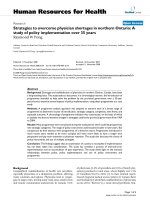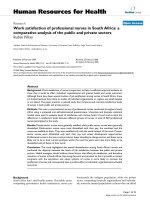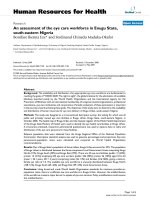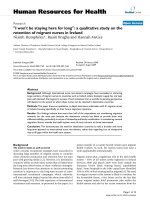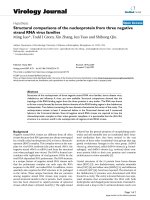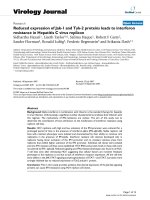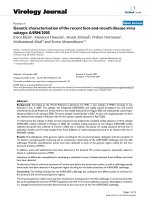báo cáo sinh học:" Work satisfaction of professional nurses in South Africa: a comparative analysis of the public and private sectors Rubin Pillay" pot
Bạn đang xem bản rút gọn của tài liệu. Xem và tải ngay bản đầy đủ của tài liệu tại đây (277.39 KB, 10 trang )
BioMed Central
Page 1 of 10
(page number not for citation purposes)
Human Resources for Health
Open Access
Research
Work satisfaction of professional nurses in South Africa: a
comparative analysis of the public and private sectors
Rubin Pillay
Address: School of Business and Finance, University of Western Cape, Bellville, Cape Town, South Africa
Email: Rubin Pillay -
Abstract
Background: Work satisfaction of nurses is important, as there is sufficient empirical evidence to
show that it tends to affect individual, organizational and greater health and social outcomes.
Although there have been several studies of job satisfaction among nurses in South Africa, these
are limited because they relate to studies of individual organizations or regions, use small samples
or are dated. This paper presents a national study that compares and contrasts satisfaction levels
of nurses in both public and private sectors.
Methods: This was a cross-sectional survey of professional nurses conducted throughout South
Africa using a pretested and self-administered questionnaire. Univariate and bivariate statistical
models were used to evaluate levels of satisfaction with various facets of work and to elicit the
differences in satisfaction levels between different groups of nurses. A total of 569 professional
nurses participated in the study.
Results: Private-sector nurses were generally satisfied, while public-sector nurses were generally
dissatisfied. Public-sector nurses were most dissatisfied with their pay, the workload and the
resources available to them. They were satisfied only with the social context of the work. Private-
sector nurses were dissatisfied only with their pay and career development opportunities.
Professional nurses in the more rural provinces, those intending to change sectors and those more
likely not to be in their current positions within the next five years were also more likely to be
dissatisfied with all facets of their work.
Conclusion: This study highlighted the overall dissatisfaction among South African nurses and
confirmed the disparity between the levels of job satisfaction between the public and private
sectors. Health managers should address those factors that affect job satisfaction, and therefore
retention, of nurses in South Africa. Improving the work environment so that it provides a context
congruent with the aspirations and values systems of nurses is more likely to increase the
satisfaction of nurses and consequently have a positive effect on individual, organizational and health
outcomes.
Background
South Africa has a dual health system. The public sector,
comprising government health institutions, serves pre-
dominantly the indigent population, while the private
sector, comprising for-profit organizations and individu-
als, serves the insured population or those who can afford
Published: 20 February 2009
Human Resources for Health 2009, 7:15 doi:10.1186/1478-4491-7-15
Received: 25 February 2008
Accepted: 20 February 2009
This article is available from: />© 2009 Pillay; licensee BioMed Central Ltd.
This is an Open Access article distributed under the terms of the Creative Commons Attribution License ( />),
which permits unrestricted use, distribution, and reproduction in any medium, provided the original work is properly cited.
Human Resources for Health 2009, 7:15 />Page 2 of 10
(page number not for citation purposes)
care on an out-of-pocket basis. Although the public sector
is responsible for the well-being of 82% of the popula-
tion, it accounts for only 40% of the total health expend-
iture in South Africa. In contrast, the private sector
consumes 60% of the health expenditure and is responsi-
ble for less than 20% of the population [1]. The public
sector, which is underresourced and overused, is often
characterized as being inefficient and ineffective in terms
of meeting its mandate of accessible, affordable and
appropriate health care. The private sector, on the other
hand, is reputed for its world-class facilities and care pro-
vision.
Given the pivotal role that nurses play in determining the
efficiency, effectiveness and sustainability of health care
systems, it is important to understand what motivates
them and the extent to which the organization and other
contextual variables satisfy them. Job dissatisfaction has
frequently been cited as the primary reason for a high
turnover of nurses [2-5], as well as increased rates of
absenteeism [6], both of which impede efficiency and
effectiveness, which in turn pose a threat to a health care
organization's capacity to provide good care as well as
meet the needs of patients [7,8]. This may result in a
decrease in morale and productivity of the remaining
nurses due to the increasing pressure on them [9], which
in turn has the potential to contribute to further work dis-
satisfaction and a further increase in nurse turnover [10].
In addition, work satisfaction was found to be an impor-
tant predictor of where health professionals intended to
work [11,12].
Work satisfaction is also an essential part of ensuring
high-quality care. Dissatisfied providers not only give
poor quality, less efficient care [13], there is also evidence
of a positive correlation between professional satisfaction
and patient satisfaction and outcomes [3,14-16]. Nurses
who were not satisfied at work were also found to distance
themselves from their patients and their nursing chores,
resulting in suboptimal quality of care [17]. Baxter [18]
further highlighted the strong influence of nurse job satis-
faction on the quality of care they provided as well as on
the nurse-patient relationship [19].
There is also compelling evidence of a positive relation-
ship between job satisfaction and employee health. Ble-
gen et al. [20] demonstrated a strong negative association
between work satisfaction and stress, while Grieshaber et
al. [21] showed that dissatisfaction led to increased stress
and frustration, which resulted in physical, emotional and
behavioral problems. This has been found to be an impor-
tant contributor to suboptimal performance of nurses
[22] as well as to abandonment of the profession [23].
Job satisfaction has primarily been defined by two
approaches: a global approach that encompasses overall
attitudes, feelings and emotions towards their work expe-
rience [24,25], and a faceted approach that emphasizes
employees' attitudes towards individual aspects of their
job [26,25], which is more useful at determining specific
areas for improvement [27].
Although international research varies in its specific find-
ings, the general conclusions seem to support a sentiment
of growing dissatisfaction experienced by nurses around
the world [28-32]. Key dissatisfactors were found to
include non-supportive work environments [33] and
increased workloads [34,35], while important predictors
of nurse work satisfaction included autonomy [36,37],
work content [38], professional development and recog-
nition [39], and relationships with co-workers and peers
[40]. Although the literature on the subject demonstrates
areas of commonality, it also highlights significant differ-
ences between different labour markets [26].
In South Africa, nurses were also found to be generally dis-
satisfied [41,42], with remuneration being a key contribu-
tor to dissatisfaction [42-45]. Poor working conditions
and organizational climate were also strong predictors of
dissatisfaction [43,46], while the social context of the job
was found to be a strong predictor of satisfaction
[43,45,47]. The South African studies are, however, lim-
ited in the sense that they relate to studies in individual
organizations [43], are done at regional level [46,45],
used small samples [46], or used data collected prior to
the sociopolitical transition and health system transfor-
mation [41,42]. There have been no recent studies of this
phenomenon nationally, and none have compared and
contrasted work satisfaction levels of nurses in the differ-
ent sectors. This paper is an attempt to address this gap in
the literature.
Methods
Data for this study came from a survey of professional
nurses throughout South Africa that formed part of a
broader study of attraction, work satisfaction and reten-
tion issues. Based on a population of 99 534 professional
nurses registered with the South African Nurses Council,
the minimum sample size was calculated at 367, at a 95%
level of certainty and allowing for a margin of error of 5%.
Based on a response rate of around 40% for similar stud-
ies [11], a computer-generated simple random sample of
1000 professional nurses was selected. A self -adminis-
tered questionnaire that had been specially developed and
pretested was posted to nurses in September 2006 and
non-responders were sent questionnaires up to two more
times at intervals of four weeks. Data collection was termi-
nated six weeks after the final mailing. The results of a
sample of primary non-responders (non-respondents to
Human Resources for Health 2009, 7:15 />Page 3 of 10
(page number not for citation purposes)
the first mailing attempt) were compared to that of the
primary responders (respondents to the first mailing
attempt) to assess non-response bias [48].
The objective of this study was to determine the extent of
work satisfaction among nurses and to examine variables
influencing 13 aspects of job satisfaction. Scales combin-
ing multiple items were used to measure satisfaction with
autonomy, relationship with nursing colleagues, patient
care, relationship with doctors, personal time, relation-
ship with management, career opportunities, safety, the
community, pay, resources, workload and satisfaction
with their careers. Some of the items and scales were
developed by the researcher, while others were adapted
from the literature [3,27,49-51].
Factor analysis using principal components analysis was
used to evaluate the construct validity of the satisfaction
subscales and the Kaiser's eigenvalue rule was used to
determine the factors to be extracted from the 58 satisfac-
tion items. Satisfaction was measured by means of a five-
item Likert scale ranging from 1 (very dissatisfied) to 5
(very satisfied). The reliability of the factors was estimated
by assessing the internal consistency of the scales by
means of Cronbach's alpha. The ultimate score that each
nurse received for each factor was based on the simple
summation of the item scores for that measure. Mean fac-
tor scores at the lower end of the score range denote lower
satisfaction with a particular facet, while higher scores
denote satisfaction.
The independent variables in the study were the respond-
ent's personal characteristics, work experience and future
work plans. One-way analysis of variance (ANOVA) was
used to test the statistical significance of the differences in
work satisfaction between nurses in the public and private
sectors and other categorical variables, while the chi-
square test was used to test the statistical significance of
the association between categorical variables.
Results
After the primary and two follow-up surveys, question-
naires were returned from 569 of 907 valid addresses of
professional nurses. This represents a total response rate
of 62.7%. There were no significant differences between
primary respondents (297) and the sample of primary
non-respondents in terms of demographics, future work
plans and satisfaction levels.
As shown in Table 1, most respondents were female
(94.1%), above the age of 40 (73.1%) and had more than
20 years' experience (60.4%). Most of the respondents
were from Gauteng (26.8%), Kwa-Zulu Natal (20.8%)
and the Western Cape (16%), while Mpumalanga (4.8%),
North West (4.3%) and Northern Cape (2%) had the
fewest respondents.
About 40% of respondents worked in the private sector,
while 60% worked in the public sector. Some 34.8% of
respondents indicated an intention to change their sector
of employment within the next five years, while 30.2%
reported that they would most likely still be in their cur-
rent positions as professional nurses in five years' time.
Factor analysis yielded the same 13 facets that captured
76% of the variance in nurses' responses to the satisfac-
tion items. Cronbach's alpha–a measure of internal con-
sistency–was well within acceptable range for all scales (α
> 0.70).
Overall, professional nurses in South Africa were margin-
ally dissatisfied (mean 2.935) (Table 2). They did, how-
ever, express greatest satisfaction in their relationship with
patients and the gratification they obtained from patient
care (3.734), their relationship with their nursing col-
leagues (3,582), doctors (3.391) and their sense of
belonging in the communities within which they work
(3.368). They were most dissatisfied with their pay
(2.020), the workload (2.244), their career development
opportunities (2.595) and the resources available to them
(2.727).
Private-sector nurses were generally satisfied (3.321).
They expressed greatest satisfaction with the gratification
they obtained from patient care (3.984), their relation-
ship with their nursing colleagues (3.697), their sense of
belonging in the communities within which they work
(3.598), safety in the work environment (3.570) and their
relationship with doctors. They were dissatisfied only with
their pay (2.397) and career development opportunities
2.987).
Public-sector nurses were generally dissatisfied (2.693).
They did, however, express satisfaction with the gratifica-
tion they obtained from patient care (3.571), their rela-
tionship with their nursing colleagues (3.514) and
doctors (3.317) and their sense of belonging in the com-
munities within which they work (3.226). They were most
dissatisfied with their pay (1.787) and workload (1.940),
followed by the resources available to them (2.306),
career development opportunities (2.337) and safety of
the work environment (2.351).
Analysis of variance showed significant differences
between the satisfaction levels of nurses with different
bio-demographic characteristics, from different provinces,
with different levels of experience, in the different sectors,
as well as those who intended to change sectors or had
other work plans within the next five years (Table 3).
Human Resources for Health 2009, 7:15 />Page 4 of 10
(page number not for citation purposes)
Table 1: Respondent characteristics and future work plans
Frequency Valid percentage
Gender (N = 559) Male 33 5.9
Female 526 94.1
Total 559 100
Age (N = 562) < 30 24 4.3
30–40 127 22.6
> 40 411 73.1
Total 562 100
Place of employment (N = 557) Mpumalanga 27 4.8
Limpopo 42 7.5
Northern Cape 11 2
Gauteng 149 26.8
Free State 36 6.5
North West 24 4.3
Eastern Cape 63 11.3
Kwa-Zulu Natal 116 20.8
Western Cape 89 16
Total 557 100
Sector of employment (N = 550) Private 219 39.8
Public 331 60.2
Total 550 100
Intention to change sector (N = 540) Yes 188 34.8
No 352 65.2
Total 540 100
Years of nursing experience (N = 563) 0–9 66 11.7
10–19 157 27.9
> 20 340 60.4
Total 563 100
Work plan for next 5 years (N = 536) Remain in current position 162 30.2
Human Resources for Health 2009, 7:15 />Page 5 of 10
(page number not for citation purposes)
Female nurses were generally more satisfied with
resources than their male colleagues (F = 3.85, p < 0.05),
while nurses above age 40 were significantly more satis-
fied than their younger colleagues with their relationships
with management (F = 2.831, p < 0.05) and with doctors
(F = 4.611, p < 0.01). Nurses with more than 20 years'
experience were also significantly more satisfied than their
less-experienced colleagues with most of the facets of their
work.
Nurses in the Western Cape, Free State, Kwa-Zulu Natal
and Gauteng were significantly more satisfied than their
colleagues from other provinces with most of the facets of
their work except for their relationships with the commu-
Leaving nurse for another profession 68 12.7
Quit nursing and retire from all forms of employment 50 9.3
Work abroad 84 15.7
Further training in nursing 125 23.3
Others 47 8.8
Total 536 100
Table 1: Respondent characteristics and future work plans (Continued)
Table 2: Reliability and descriptive statistics for work satisfaction subscales
Satisfaction All respondents Private sector Public sector
Factors N of items Cronbach's alpha Mean N of items Cronbach's alpha Mean N of items Cronbach's alpha Mean
Autonomy 4 0.869 3.059 4 0.854 3.487 4 0.85 2.803
Resources 5 0.887 2.727 5 0.848 3.397 5 0.84 2.306
Career opportunities 6 0.925 2.592 6 0.936 2.987 6 0.896 2.337
Relation with nurses 4 0.897 3.582 4 0.893 3.697 4 0.901 3.514
Patient care 5 0.878 3.734 5 0.867 3.984 5 0.872 3.571
Relation with
management
5 0.96 2.679 5 0.966 3.124 5 0.943 2.406
Relation with doctors 4 0.939 3.391 4 0.941 3.528 4 0.939 3.317
Personal time 4 0.917 2.868 4 0.939 3.12 4 0.896 2.706
Safety 4 0.925 2.839 4 0.923 3.57 4 0.878 2.351
Community 3 0.902 3.368 3 0.915 3.598 3 0.887 3.226
Pay 4 0.919 2.02 4 0.934 2.397 4 0.881 1.787
My career 4 0.87 3.047 4 0.888 3.507 4 0.835 2.751
Workload 5 0.922 2.244 5 0.927 2.777 5 0.889 1.94
Overall satisfaction 2.935 3.321 2.693
Human Resources for Health 2009, 7:15 />Page 6 of 10
(page number not for citation purposes)
nity, where nurses in Limpopo and North West were more
satisfied.
Nurses in the private sector were also significantly more
satisfied with all facets of their work than their colleagues
in the public sector. The greatest differences in satisfaction
levels were with regard to safety, resources available,
workload, their careers and their relationship with man-
agement, respectively
Nurses who intended to change their sector of employ-
ment were significantly less satisfied in all the work facets
than those who indicated that they would not be chang-
ing their sector of employment. Nurses who intended to
remain active in the profession for the next five years were
also significantly more likely to report being satisfied with
all the facets of their work, as opposed to those whose
work plans included either quitting the profession, work-
ing abroad or pursuing further training in nursing.
Results and discussion
Given that it is difficult to achieve desirable response rates
in surveys of health professionals, the relatively high
response rate of more than 60% suggests that the iterative
process is appropriate in this context. It may also indicate
high interest among nurses in the subject area. The simi-
larity in response rates between respondents and a sample
of primary responders suggests that non-response bias
was minimal and the sample was therefore representative
of all professional nurses in South Africa.
Results from the survey demonstrate that although nurses
are generally dissatisfied, discrepancies are masked
between levels of satisfaction with different aspects of
their work, between nurses with different bio-demo-
graphic characteristics, between nurses in the different sec-
tors and from different geographic regions, and between
nurses with different future work plans.
The overall dissatisfaction among the cohort surveyed is
disconcerting, given that work satisfaction is positively
correlated to increased absenteeism [6] and turnover [2-
Table 3: Differences in satisfaction levels between different categories of nurses: ANOVA F-values and levels of significance (p)
Satisfaction
factors
Gender Age Province Sector Change
sector
Experience Work plan Return
Autonomy 0.904 (0.342) 0.449 (0.639) 1.410 (0.189) 64.985 (0.000) 48.767 (0.000) 2.272 (0.104) 17.040 (0.000) 2.810 (0.066)
Resources 3.850 (0.050) 0.022 (0.978) 3.770 (0.000) 225.148 (0.000) 17.941 (0.000) 3.005 (0.030) 19.399 (0.000) 3.378 (0.039)
Career
opportunities
0.065 (0.798) 2.793 (0.062) 1.643 (0.110) 60.310 (0.000) 57.493 (0.000) 7.389 (0.001) 22.204 (0.000) 1.972 (0.146)
Relation with
nurses
0.160 (0.689) 0.287 (0.751) 1.350 (0.216) 5.793 (0.016) 7.617 (0.001) 0.133 (0.941) 5.470 (0.000) 1.240 (0.295)
Patient care 1.240 (0.266) 1.911 (0.149) 0.492 (0.862) 35.100 (0.000) 12.951 (0.000) 3.297 (0.038) 8.352 (0.000) 0.747 (0.477)
Relation with
management
0.047 (0.828) 2.831 (0.060) 2.579 (0.009) 58.031 (0.000) 60.079 (0.000) 6.974 (0.001) 21.720 (0.000) 0.914 (0.405)
Relation with
doctors
0.546 (0.460) 4.611 (0.010) 2.062 (0.038) 5.425 (0.020) 6.131 (0.002) 3.735 (0.011) 3.901 (0.002) 0.437 (0.647)
Personal time 0.529 (0.467) 0.790 (0.455) 2.742 (0.006) 22.198 (0.000) 9.478 (0.000) 2.374 (0.069) 7.157 (0.000) 1.617 (0.207)
Safety 0.589 (0.443) 0.661 (0.517) 5.317 (0.000) 188.452 (0.000) 27.226 (0.000) 3.793 (0.010) 16.494 (0.000) 2.461 (0.092)
Community 0.049 (0.825) 1.914 (0.149) 3.245 (0.001) 19.480 (0.000) 14.037 (0.000) 3.525 (0.015) 10.518 (0.000) 0.904 (0.409)
Pay 0.452 (0.501) 1.190 (0.305) 2.239 (0.023) 56.230 (0.000) 27.994 (0.000) 2.539 (0.056) 21.161 (0.000) 1.483 (0.233)
My career 0.585 (0.445) 1.640 (0.195) 1.962 (0.049) 78.945 (0.000) 24.174 (0.000) 3.337 (0.019) 20.555 (0.000) 3.848 (0.025)
Workload 0.063 (0.803) 0.414 (0.661) 2.135 (0.031) 97.721 (0.000) 32.510 (0.000) 1.913 (0.149) 12.914 (0.000) 1.617 (0.207)
Human Resources for Health 2009, 7:15 />Page 7 of 10
(page number not for citation purposes)
5], nurse morale and health [21,20], productivity [9] and
clinical outcomes [3,14-16]. This, in turn, has implica-
tions for the efficiency, effectiveness and sustainability of
our health care system.
Overall, nurses in the public sector were generally dissat-
isfied, while nurses in the private sector were satisfied.
This contradicts the general management literature, which
suggests that public sector satisfaction has improved rela-
tive to the private sector over the last decades [52]. It does,
however, support the nursing management literature,
which demonstrates significant dissatisfaction among
public-sector nurses relative to their private-sector col-
leagues [53], suggesting that the work milieu in the public
sector does not meet the aspirations and values systems of
nurses.
Public-sector nurses were most dissatisfied with their pay,
workload and the resources available to them, while pri-
vate-sector nurses were moderately dissatisfied with pay
and workload and marginally dissatisfied with their career
opportunities. Although both sectors have identified pay
and workload as being an important source of dissatisfac-
tion, private-sector nurses are relatively more satisfied
with these factors than their public-sector counterparts.
The question then arises: Why are private-sector nurses
significantly more satisfied than their public-sector col-
leagues? The data suggest that nurses in both sectors were
satisfied with the social context of their work (relation-
ships with colleagues, doctors and communities) and the
intrinsic satisfaction they receive from patient care. In
other words, they are happy with the work they do and the
people with whom they work. This is positive, given that
optimal health provision depends on teamwork and
interprofessional cooperation and communication.
The differences in satisfaction are related to the work con-
text: safety, resources, workload and work schedule, man-
agement, pay and autonomy. The biggest difference in
satisfaction levels was in the perceived levels of safety in
the workplace–personal safety, risk of infection, risk of
injury and the physical work environment. Public-sector
nurses were extremely dissatisfied, while private-sector
nurses were satisfied. The emergence of deadly diseases
such as extreme drug-resistant tuberculosis (XDR TB) and
HIV/AIDS, in the wake of the already burdened public
health care system, probably contributes to the weakening
of the safety of the nursing work environment. In addi-
tion, patients with these illnesses generally require more
specialized care and longer-term treatment than other
patients, further increasing the workload.
Andrews & Dziegielewski [54] in their study on nurses in
the United States of America also highlighted nursing as a
hazardous occupation, with job-related injury and ill-
nesses among nurses being among the highest in the
workforce. There is also sufficient anecdotal evidence to
suggest that nurses are also frequently victims of bullying
from managers and more senior colleagues and physical
violence or threats of violence, often from patients or
patients' relatives. Nurses are therefore being restricted
from working to their full potential and providing total
commitment as a result of their constrained environment.
Total commitment of knowledge workers, according to
Davenport [55], depends upon providing an environment
that encourages adequate use of their abilities. The availa-
bility of protective materials and functional equipment to
safeguard nurses from unnecessary accidents, as well the
implementation of structures and processes to help nurses
improve their personal safety skills and provide support
for victims of workplace violence [56], will help contrib-
ute to a safer environment for nurses in the public health
care setting.
The difference in satisfaction levels with resources availa-
ble–working equipment, medication, examination facili-
ties, time and staff–is also stark, with nurses working in
private health care afforded the ideal opportunity to
improve the health care status of patients in an optimal
setting with adequate resources and time. This translates
into more efficient, effective health care in a more com-
fortable environment, which ensures that patients
become the priority and patients' needs are met.
The issue of nurse remuneration, especially in the public
sector, has been an enduring one [45,47,42,41]. This may
partly explain the move of so many public sector nurses to
the private sector. Higher salaries offered by overseas hos-
pitals are also proving to be an ideal pull factor. However,
it is hoped that the Occupation Specific Dispensation,
which significantly improved the salaries of public sector
nurses and which was implemented in January 2008 and
backdated to June 2007, will address this issue to some
extent. Health administrators will also do well to link por-
tions of remuneration to performance objectives such as
quality of care, resource conservation and patient-centric
care, as well as to consider non-financial (e.g. career devel-
opment opportunities) and psychological rewards (e.g.
gratitude and recognition) [57].
An increased workload for nurses–resulting from the
severe shortage of nurses as well as an increase in demand
for care–has been associated with burnout and intention
to leave [23]. Excessive workload has been shown to sig-
nificantly contribute to public- and private-sector nurses'
dissatisfaction in South Africa. Tzeng [3] was able to dem-
onstrate in her study among Taiwanese nurses that work-
load was a predictor of nurse turnover. This results in
increased workload for the remaining nurses, which in
turn decreases the morale and productivity of those who
Human Resources for Health 2009, 7:15 />Page 8 of 10
(page number not for citation purposes)
remain, further increasing turnover [9]. The implications
of these findings are therefore alarming for the provision
of health care in South Africa now and in the future, given
that we are already facing challenges with regard to nurse
retention. In addition, the long, irregular and inflexible
working hours have the potential to adversely affect fam-
ily dynamics. Consideration should be given to improv-
ing scheduling and providing day care for children and
more part-time employment, all of which are bound to
have a positive effect on the personal lives of nurses as
well.
The general dissatisfaction of public-sector nurses with
their careers and the career opportunities available to
them is a further measure of demoralization of nurses and
offers some substantiation of the disaffection associated
with working in the public sector. The decreasing attrac-
tiveness of nursing as a career is of great concern, given
that nurses play a central role in the government's primary
health care approach. Attraction, retention and motiva-
tion difficulties may in the long run offset the gains of
attempts to improve efficiency within the health delivery
system. The results were marginal, but the data indicated
that private-sector nurses were also dissatisfied with career
opportunities available to them as nurses in South Africa.
Although this finding is not supported by Barrows &
Wesson [54], who found private-sector employees signifi-
cantly more satisfied with their career opportunities than
their public-sector counterparts, this may partly explain
why private-sector nurses leave the profession or the
country.
Career opportunities and training afford individuals the
prospect of further developing themselves and growing
within the ranks of their career. They also acknowledge
experience and time dedicated to nursing, which provides
much-needed recognition in the field of nursing. These
findings are in line with the suggestion by Horwitz et al.
[58] who proposed that highly effective strategies for
motivation and retention of knowledge workers need to
be centred on creating a stimulating and challenging envi-
ronment. Career development was identified by Irvine &
Evans [59] as contributing significantly to decreased job
turnover and it is therefore a crucial management func-
tion.
The significantly different responses to the satisfaction fac-
tors by nurses intending to leave their current employ-
ment sector and those not intending to leave are
confirmation of the push factors that direct the ultimate
movement of nurses out of the public sector into the pri-
vate sector. Responses to all factors were significantly dif-
ferent and the levels of satisfaction experienced by the
nurses who intend to leave their current sector were signif-
icantly lower for all factors than those who intend to stay.
These results support the findings of Shields & Ward [8]
that work dissatisfaction is a strong predictor of intention
to quit and confirm the findings of Pillay [11] that work
satisfaction is an important predictor of where health pro-
fessionals intended to work. They underscore the conse-
quences of failure to address nurses' causes of
dissatisfaction, which reflect the many hygiene factors
[60]. This further highlights the need for government to
recognize the needs of nurses and work towards improv-
ing them. Failure to do so may well result in increased
migration of nurses out of the public sector and the coun-
try.
The finding that nurses in the more urbanized provinces
(Western Cape, Free State, Kwa-Zulu Natal and Gauteng)
were significantly more satisfied than their colleagues
from the more rural provinces may also partly explain the
gravitation of nurses from rural to urban areas. This fur-
ther supports that assertion of Pillay [11] that:
work satisfaction is an important predictor of where
health professionals intended to work. Health manag-
ers in rural provinces should therefore focus on key
dissatisfactors if they are to improve retention of
nurses in their regions. It was however interesting to
note that that nurses in the more rural provinces were
significantly more satisfied with their relationships
with the communities within which they work. The
role that communities can play in the recruitment and
retention of nurses therefore offers us a key point of
leverage to improve recruitment and retention efforts
and definitely warrants more research.
The work experience of a nurse was also a significant var-
iable that resulted in varying responses to the levels of sat-
isfaction among the given factors. Nurses with more than
20 years' experience were more satisfied with most of the
satisfaction facets than those nurses with less work experi-
ence. Years of experience bring with them a sense of secu-
rity in nursing, and fewer surprises. Relationships with
patients and colleagues are built and strengthened over
the years that are more difficult to establish when one is
less experienced. Experience also has the advantage of
promoting nurses within the ranks and reserving the more
menial tasks to the less experienced and younger nurses,
thereby offering a manageable workload and flexible
working hours. These factors are satisfying to nurses and
help explain the overall higher levels of satisfaction
among the more experienced nurses. This augurs well for
the retention of the more experienced nurses, with the
associated benefits of institutional memory retention and
coaching and mentoring of new entrants.
This study had limitations that must be acknowledged.
First, responders may have been more dissatisfied than
Human Resources for Health 2009, 7:15 />Page 9 of 10
(page number not for citation purposes)
non-responders, leading to exaggerated estimates of dis-
satisfaction. Second, the research relied on subjective
assessments of respondents to the survey and it was not
possible to externally validate these responses.
Conclusion
This study highlighted the overall dissatisfaction among
South African nurses and confirmed the disparity between
the levels of job satisfaction between the public and pri-
vate sectors. Nurses are pivotal to the effective and effi-
cient delivery of health care in South Africa; the chronic
shortages of nurses impose a real threat to its future. It
therefore becomes imperative for health care managers to
identify and address those factors which are the stumbling
blocks to job satisfaction and therefore retention of nurses
in South Africa. Improving the work environment so that
it provides a context congruent with the aspirations and
values systems of nurses is more likely to increase the sat-
isfaction of nurses and consequently have a positive effect
on individual, organizational and health outcomes.
Competing interests
The author declares that they have no competing interests.
References
1. Health Systems Trust: Annual Health Review 2005 [http://
www.hst.org.za/uploads/files/sahr2006.pdf]. accessed 10/08/06.
2. Lambert EG, Hogan N, Barton SM: The impact of job satisfaction
on turnover intent: a test of a structural measurement
model using a national sample of workers. The Social Science
Journal 2001, 38(2):233-250.
3. Tzeng HM: The influence of nurses' working motivation and
job satisfaction on intention to quit an empirical investiga-
tion in Taiwan. International Journal of Nursing Studies 2002,
39:867-878.
4. Yin JT, Yang KA: Nursing turnover in Taiwan: a meta-analysis
of related factors. International Journal of Nursing Studies 2002,
39:573-581.
5. Larabee J, Janney M, Ostrow CL, Witbrow ML, Hobbs GR, Burant C:
Predicting registered nurses job satisfaction and intent to
leave. Journal of Nursing Administration 2003, 33(5):271-283.
6. Siu O: Predictors of job satisfaction and absenteeism in two
samples of Hong Kong nurses. Journal of Advanced Nursing 2002,
40(2):218-229.
7. Tai T, Barne S, Robinsin C: Research of nursing turnover
research. Social Science and Medicine 1998, 12:1905-1924.
8. Shields MA, Ward M: Improving nurse retention in the
National Health Service in England: the impact of the job
satisfaction on intentions to quit. Journal of Health Economics
2001, 20(5):677-701.
9. Cavanagh S, Coffin D: Staff turnover among hospital nurses.
Journal of Advanced Nursing 1992, 17:1369-1376.
10. Borda GL, Norman IJ: Factors influencing turnover and absence
of nurses a research review. International Journal of Nursing Studies
1997, 34(6):385-394.
11. Pillay R: Effect of organisational structure and managerial
practices on the clinical behavior and job satisfaction of pri-
mary healthcare doctors as knowledge workers, in the man-
aged healthcare industry in South Africa. In PHD Thesis
University of Cape Town; 2002.
12. Department of Health and Community Services (DHCS): The Realities
of RuralDistrict Nursing: A Study of PracticeIssues and Educational Needs.
Lodden Mallee Region Progressive Projects Canberra: Lampshire and
Rolfe; 1993.
13. Grol R, Lawrence M: Quality Improvement by Peer Review London:
Oxford University Press; 1995.
14. Leiter M, Harvie P, Frizzell C: The correspondence of patient
satisfaction and nurse burnout. Social Science and Medicine 1998,
47(10):1611-1617.
15. Linn L, Brook R, Clark V: Physician and patient satisfaction as
factors related to organisation of internal medicine group
practices. Medical Care 1985, 23(10):1171-1178.
16. Weisman CS, Nathanson CA: Professional Satisfaction and Cli-
ent Outcomes. Medical Care 1985, 23(10):1179-1191.
17. Demerouti E, Bekker A, Nachreiner F, Schaufeli W: A model of
burnout and life satisfaction amongst nurses. Journal of
Advanced Nursing 2000, 32(2):454-464.
18. Baxter V: Nurses' perception of their role and skills in a
medium secure unit. British Journal of Nursing 2002, 11:1312-1321.
19. Takase M, Maude P, Manias E: Explaining nurses' work behaviour
from their perception of the environment and work values.
International journal of Nursing Studies 2005, 42:889-898.
20. Blegen MA, Mueller CW: Nurses' job satisfaction: a longitudinal
analysis. Research in Nursing and Health 1987, 10:227-237.
21. Grieshaber LD, Parker P, Deering J: Job satisfaction of nursing
assistants in long-term care. Health Care Supervisor 1995,
13(4):18-28.
22. Kendrick P: Comparing the effects of stress and relationship
style on student and practicing nurse anesthetics. American
Association of Nurse Anesthetists Journal 2000, 68:15-22.
23. Cameron SJ, Horsburgh ME, Armstrong-Stassen M: Job satisfaction,
propensity to leave and burnout in RNs and RNAs: a multi-
variate perspective. Canadian Journal of Nursing Administration
1994, 7(3):43-64.
24. Spector PE: Job Satisfaction: Application, Assessment, Causes, and Conse-
quences London: Sage Publications; 1997.
25. Locke E: The nature and causes of job satisfaction.
In Handbook
of Industrial and Organizational Psychology Edited by: Dunnette M. New
York: J. Wiley & Sons; 1983:1297-1347.
26. Lu H, While AE, Barriball KL: Job satisfaction among nurses – a
literature review. International Journal of Nursing Studies 2004,
42:221-227.
27. Coomber B, Barriball KL: Impact of job satisfaction components
on intent to leave and turnover for hospital-based nurses: A
review of the research literature. International Journal of Nursing
Studies 2006, 44:297-314.
28. Aiken L, Clarke S, Sloane D, Sochalski J, Busse R, Clarke H, Giovan-
netti P, Hunt J, Rafferty A, Shamian J: Nurses' reports on hospital
care in five countries. Health Affairs 2002, 20(3):43-53.
29. Hart PD: The nurse shortage: Perspectives from current
direct care nurses and former direct care nurses. 2000 [http:/
/www.aft.org/pubs-reports/healthcare/Hart_Report.pdf].
30. Lundh U: Job satisfaction among Swedish nurses and labora-
tory technologists. British Journal of Nursing 1999, 8(14):948-952.
31. Suliman WA, Abu Gharieb P: Jordanian nurse: Job dissatisfaction
and anticipated withdrawal from practice. Dirasat, medical and
biological 1996, 23(2):78-87.
32. Lee FK: Job satisfaction and autonomy of Hong Kong regis-
tered nurses. Journal of Advanced Nursing 1998, 27:355-363.
33. Sims CE: Increasing clinical, satisfaction, and financial per-
formance through nurse-driven process improvement. Jour-
nal of Nursing Administration 2003, 33(2):68-75.
34. Healy C, McKay M: Identifying sources of stress and job satis-
faction in the nursing environment. Australian Journal of Advanced
Nursing 2000, 17:30-35.
35. Happel B, Martin T, Pinikahana J: Burnout and Job satisfaction: a
comparative study of psychiatric nurses from forensic and
mainstream mental health service. International Journal of Mental
Health Nursing 2003, 12:39-47.
36. Finn CP: Autonomy: an important component for nurse's job
satisfaction. International Journal of Nursing Studies 2001,
38(3):349-357.
37. O'Rourke K, Allgood C, Vanderslice J, Hardy MA: Job satisfaction
among nursing staff in a military health care facility. Military
medicine 2000, 165(10):757-761.
38. Nolan M, Nolan J, Grant G: Maintaining nurses' job satisfaction
and morale. British Journal of Nursing 1995, 4(19):1148-1154.
39. Lyon KJ: A study of job satisfaction of nursing and allied health
graduates from a mid-Atlantic university. Journal of Allied
Health 2003, 32(1):10-17.
Publish with Bio Med Central and every
scientist can read your work free of charge
"BioMed Central will be the most significant development for
disseminating the results of biomedical research in our lifetime."
Sir Paul Nurse, Cancer Research UK
Your research papers will be:
available free of charge to the entire biomedical community
peer reviewed and published immediately upon acceptance
cited in PubMed and archived on PubMed Central
yours — you keep the copyright
Submit your manuscript here:
/>BioMedcentral
Human Resources for Health 2009, 7:15 />Page 10 of 10
(page number not for citation purposes)
40. Adams A, Bond S: Hospital nurses' job satisfaction, individual
and organizational characteristics. Journal of Advanced Nursing
2000, 32(3):536-543.
41. Kaplan RA, Boshoff AB, Kellerman AM: Job involvement and job
satisfaction of South African nurses compared to other Pro-
fessions. Curationis 1991, 14(1):3-7.
42. Westaway MS, Wessie GM, Viljoen E, Booysen U, Wolmarans L: Job
satisfaction and the self esteem of South African Nurses.
Curationis 1996, 19(3):17-20.
43. Kekana HP, Du Rand EA, van Wyk NC: Job satisfaction of regis-
tered nurses in a community hospital in the Limpopo Prov-
ince in South Africa. Curationis 2007, 30(2):24-35.
44. Erasmus BJ, Brevis T: Aspects of the working life of women in
the nursing profession in South Africa: survey results. Cura-
tionis 2005, 28(2):51-60.
45. Uys LR, Minnaar A, Reid S, Simpson B: The Effect of Two Models
of Supervision on Selected Outcomes. Journal OF Nursing Schol-
arship 2005, 37(3):282-288.
46. Lephoko CS, Bezuidenhout MC, Roos JH: Organizing climate as a
cause of job dissatisfaction among nursing staff in selected
hospitals within the Mpumalanga Province. Curationis 2006,
29(4):28-36.
47. Erasmus BJ: Nursing Professionals views on the Workplace.
Curationis 1998, 21(4):50-57.
48. Armstrong JS, Overton TS: Estimating Non response Bias in
Mail Surveys. Journal of Marketing Research 1977, 14(3):396-402.
49. Van Saane N, Sluiter JK, Verbeek JH, Frings-Dresen MHW: Reliabil-
ity and validity of instruments measuring job satisfaction – a
systemic review. Occupational Health Medicine 2003, 53:191-200.
50. Seo Y, Ko J, Price JL: The determinants of job satisfaction
among hospital nurses a model estimation in Korea. Interna-
tional Journal of Nursing Studies 2004, 41:437-446.
51. Willem A, Buelens M, De Jonghe I: Impact of organizational
structure on nurses' job satisfaction: a questionnaire survey.
International Journal of Nursing Studies 2007, 44:1011-1020.
52. Barrows D, Wesson T: A comparative analysis of job satisfac-
tion among public and private sector professionals. The Inno-
vation Journal 2000, 5(1):1-21.
53. Mrayyan MT: Nurse job satisfaction and retention: comparing
public to private hospitals in Jordan. Journal of Nursing Manage-
ment 2005, 13:40-50.
54. Andrews DR, Dziegielewski SF: The nurse manager: job satisfac-
tion, the nursing shortage and retention. Journal of Nursing Man-
agement 2005, 13:286-295.
55. Davenport TH: Human Capital: What It Is and Why People Invest In It
San Francisco: Jossey-Bass Publishers; 1999.
56. Jackson D, Clare J, Manni J: Who would want to be a nurse? Vio-
lence in the workplace -a factor in recruitment and reten-
tion. Journal of Nursing Management 2002, 10:13-20.
57. Gieter SD, De Cooman R, Pepermans R, Caers R, Du Bois C, Jegers
M: Identifying nurses' rewards: a qualitative categorization
study in Belgium. Human Resources for health 2006, 4(15):.
58. Horwitz FM, Chang TH, Hesan AQ, Nonkwelo C, Roditi D, Van Eck
P: Human resource strategies for managing knowledge
workers: an Afro-Asian comparative analysis. International Jour-
nal of Human Resource Management 2006, 17(5):775-811.
59. Irvine DM, Evans MG: Job satisfaction and turnover among
nurses-integrating research across studies. Nursing Research
1995, 44(4):246-253.
60. Hertzberg F: The motivation-hygiene theory. In Organizational
Theory Edited by: Pugh DS. New York: Penguin; 1966:375-392.

